Human–Robot Interaction and Sexbots: A Systematic Literature Review
Abstract
1. Introduction
- RQ1: How are sexbots designed?
- RQ2. How do sexbots interact with humans?
- RQ3: What gender and ethical issues are related to the design and use of sexbots?
2. Background
3. Materials and Methods
4. Results
5. Discussion
5.1. RQ1: How Are Sexbots Designed?
5.2. RQ2. How Do Sexbots Interact with Humans?
5.3. RQ3: What Gender and Ethical Issues Are Related to the Design and USE of Sexbots?
- (a)
- Gender approaches
- (b)
- Ethics approaches
6. Conclusions
- -
- Some laws are in place with the aim to protect vulnerable individuals, even children.
- -
- There is a real concern about how the interactions between sexbots and human beings will become. Positive and negative consequences appeared in the literature.
- -
- The sexbot design process appears to be oriented by the opinions of human users.
- -
- Design dark patterns must be avoided in designing sexual robots.
- -
- Technology seems to be mature enough to claim a user-centered design.
- -
- Male bias is present in the design, interaction, and even ethics.
- -
- Positive therapeutic uses of sexual robots were found in the literature.
- -
- Sexual robots and dolls are used more than just sex (as companions, friendship, fantasy, etc.).
- -
- Sexual robots are stereotyped, mainly based on female figures (pornography).
- -
- Regarding data related to pedophiles and child-robots, there is currently no evidence of a relationship between the two [44]. However, restrictive regulations on child sex robots are recommended instead of open to experimentation.
Author Contributions
Funding
Institutional Review Board Statement
Informed Consent Statement
Data Availability Statement
Conflicts of Interest
References
- Goodrich, M.A.; Schultz, A.C. Human-robot interaction: A survey. Found. Trends® Human Comput. Interact. 2008, 1, 203–275. [Google Scholar] [CrossRef]
- Shen, F. Sex Robots Are Here, But Laws Aren’t Keeping up with the Ethical and Privacy Issues They Raise. 2019. Available online: https://theconversation.com/sex-robots-are-here-but-laws-arent-keeping-up-with-the-ethical-and-privacy-issues-they-raise-109852 (accessed on 29 September 2020).
- Boot, G. Lifelike and Cheap Sex Robots Made with 3D Printers Will Fuel Surge in Addiction. The Sun 2018. Available online: https://www.thesun.co.uk/tech/7998023/lifelike-and-cheap-sex-robots-made-with-3d-printers-will-fuel-surge-in-addiction/ (accessed on 29 September 2020).
- Bame, Y. 1 in 4 Men Would Consider Having Sex with a Robot. 2017. Available online: https://today.yougov.com/topics/lifestyle/articles-reports/2017/10/02/1-4-men-would-consider-having-sex-robot (accessed on 29 September 2020).
- Mackenzie, R. Sexbots: Customizing them to suit us versus an ethical duty to created sentient beings to minimize suffering. Robotics 2018, 7, 70. [Google Scholar] [CrossRef]
- Bhaumik, A. From AI to Robotics: Mobile, Social, and Sentient Robots; CRC Press: Boca Raton, FL, USA, 2018. [Google Scholar]
- Levy, D. Love and Sex with Robots: The Evolution of Human-Robot Relationships; Harper Perennial: New York, NY, USA, 2009. [Google Scholar]
- McClelland, R.T. Confronting Emerging New Technology: The Case of the Sexbots. J. Mind Behav. 2017, 38, 247–270. [Google Scholar]
- Cheok, A.D.; Levy, D.; Karunanayaka, K. Lovotics: Love and sex with robots. In Emotion in Games; Springer: Cham, Switzerland, 2016; pp. 303–328. [Google Scholar]
- Taylor, J. Sex Robot with a Personality Unveiled. Roxxxy. Metro. 2010. Available online: https://metro.co.uk/2010/01/11/worlds-first-sex-robot-with-a-personality-unveiled-as-roxxxy-23255/ (accessed on 29 September 2020).
- Harmony Realdoll. Available online: https://realbotix.com/ (accessed on 29 September 2020).
- Meet Henry, the Robot with Superhuman Sexual Prowess, Hoping to Titillate Women. 2018. Available online: https://www.rt.com/news/427246-male-sexbot-women-companionship/ (accessed on 29 September 2020).
- Hintze, A. Understanding the Four Types of AI, from Reactive Robots to Self-Aware Beings. 2016. Available online: https://theconversation.com/understanding-the-four-types-of-ai-from-reactive-robots-to-self-aware-beings-67616 (accessed on 29 September 2020).
- Cheok, A.D.; Zhang, E.Y. Sex and a History of Sex Technologies. In Human–Robot Intimate Relationships; Springer: Cham, Switzerland, 2019; pp. 23–32. [Google Scholar]
- Moher, D.; Liberati, A.; Tetzlaff, J.; Altman, D.G.; The PRISMA Group. Preferred Reporting Items for Systematic Reviews and Meta-Analyses: The PRISMA Statement. PLOS Med. 2009, 6, e1000097. [Google Scholar] [CrossRef] [PubMed]
- Green, R.D.; MacDorman, K.F.; Ho, C.C.; Vasudevan, S. Sensitivity to the proportions of faces that vary in human likeness. Comput. Hum. Behav. 2008, 24, 2456–2474. [Google Scholar] [CrossRef]
- Norton, K.I. Ken and Barbie at life size. Sex Roles 1996, 34, 287–294. [Google Scholar] [CrossRef]
- Szczuka, J.M.; Krämer, N.C. Not Only the Lonely—How Men Explicitly and Implicitly Evaluate the Attractiveness of Sex Robots in Comparison to the Attractiveness of Women, and Personal Characteristics Influencing This Evaluation. Multimodal Technol. Interact. 2017, 1, 3. [Google Scholar] [CrossRef]
- Rousi, R. Me, My Bot and His Other (Robot) Woman? Keeping Your Robot Satisfied in the Age of Artificial Emotion. Robotics 2018, 7, 44. [Google Scholar] [CrossRef]
- Hou, J.; Ye, Z. Sex Differences in Facial and Vocal Attractiveness Among College Students in China. Front. Psychol. 2019, 10, 1166. [Google Scholar] [CrossRef]
- Middleweek, B. Male homosocial bonds and perceptions of human–robot relationships in an online sex doll forum. Sexualities 2020. [Google Scholar] [CrossRef]
- Döring, N.; Pöschl, S. Sex toys, sex dolls, sex robots: Our under-researched bed-fellows. Sexologies 2018, 27, e51–e55. [Google Scholar] [CrossRef]
- James, K.B. 2040 Brad Armstrong, 2009. Porn Stud. 2017, 4, 353–360. [Google Scholar] [CrossRef]
- Burr-Miller, A.; Aoki, E. Becoming (Hetero) Sexual? The Hetero-Spectacle of Idollators and their Real Dolls. Sex. Cult. 2013, 17, 384–400. [Google Scholar] [CrossRef]
- Mariano Gomes, L.; Wu, R. User Evaluation of the Neurodildo: A Mind-Controlled Sex Toy for People with Disabilities and an Exploration of Its Applications to Sex Robots. Robotics 2018, 7, 46. [Google Scholar] [CrossRef]
- McArthur, N.; Twist, M.L. The rise of digisexuality: Therapeutic challenges and possibilities. Sex. Relatsh. Ther. 2017, 32, 334–344. [Google Scholar] [CrossRef]
- Tay, B.T.; Low, S.C.; Ko, K.H.; Park, T. Types of humor that robots can play. Comput. Hum. Behav. 2016, 60, 19–28. [Google Scholar] [CrossRef]
- Harper, C.A.; Lievesley, R. Sex Doll Ownership: An Agenda for Research. Curr. Psychiatry Rep. 2020, 22, 1–8. [Google Scholar] [CrossRef]
- Eichenberg, C.; Khamis, M.; Hübner, L. The attitudes of therapists and physicians on the use of sex robots in sexual therapy: Online survey and interview study. J. Med. Int. Res. 2019, 21, e13853. [Google Scholar] [CrossRef]
- Su, N.M.; Lazar, A.; Bardzell, J.; Bardzell, S. Of dolls and men: Anticipating sexual intimacy with robots. ACM Trans. Comput. Hum. Interact. (TOCHI) 2019, 26, 1–35. [Google Scholar] [CrossRef]
- Langcaster-James, M.; Bentley, G.R. Beyond the Sex Doll: Post-Human Companionship and the Rise of the Allodoll. Robotics 2018, 7, 62. [Google Scholar] [CrossRef]
- Döring, N.; Poeschl, S. Love and sex with robots: A content analysis of media representations. Int. J. Soc. Robot. 2019, 11, 665–677. [Google Scholar] [CrossRef]
- Whitby, B. Sometimes it’s hard to be a robot: A call for action on the ethics of abusing artificial agents. Interact. Comput. 2008, 20, 326–333. [Google Scholar] [CrossRef]
- Chatterjee, B.B. Child sex dolls and robots: Challenging the boundaries of the child protection framework. International Review of Law. Comput. Technol. 2020, 34, 22–43. [Google Scholar] [CrossRef]
- Brown, R.; Shelling, J. Exploring the implications of child sex dolls. Trends Issues Crime Crim. Justice 2019, 570, 1–13. [Google Scholar]
- Ángel, I.T.; Casado, C.M. Simulaciones sexo genéricas, bebés reborn y muñecas eróticas hiperrealistas. Opción Rev. Cienc. Hum. Soc. 2016, 81, 189–212, ISSN 1012-1587. [Google Scholar]
- Yulianto, B. Philosophy of information technology: Sex robot and its ethical issues. In Rapid Autom: Concepts, Methodologies, Tools, and Applications; IGI Global: Pennsylvania, PA, USA, 2019; pp. 1458–1467. [Google Scholar] [CrossRef][Green Version]
- Connor, S. Guys and Dolls. Women Cult. Rev. 2015, 26, 129–142. [Google Scholar] [CrossRef]
- Frank, L.; Nyholm, S. Robot sex and consent: Is consent to sex between a robot and a human conceivable, possible, and desirable? Artif. Intell. Law 2017, 25, 305–323. [Google Scholar] [CrossRef]
- Ess, C.M. What’s love got to do with it? Robots, sexuality, and the arts of being human. In Social Robots; Routledge: London, UK, 2017; pp. 57–79. [Google Scholar] [CrossRef]
- Brahnam, S.; De Angeli, A. Gender affordances of conversational agents. Interact. Comput. 2012, 24, 139–153. [Google Scholar] [CrossRef]
- Danaher, J. Regulating Child Sex Robots: Restriction or Experimentation? Med. Law Rev. 2019, 27, 553–575. [Google Scholar] [CrossRef]
- Headleand, C.J.; Teahan, W.J.; ap Cenydd, L. Sexbots: A case for artificial ethical agents. Connect. Sci. 2020, 32, 204–221. [Google Scholar] [CrossRef]
- Fiske, A.; Henningsen, P.; Buyx, A. Your robot therapist will see you now: Ethical implications of embodied artificial intelligence in psychiatry, psychology, and psychotherapy. J. Med. Int. Res. 2019, 21, e13216. [Google Scholar] [CrossRef] [PubMed]
- Nordmo, M.; Næss, J.Ø.; Husøy, M.F.; Arnestad, M.N. Friends, lovers or nothing: Men and women differ in their perceptions of sex robots and platonic love robots. Front. Psychol. 2020, 11, 355. [Google Scholar] [CrossRef] [PubMed]
- González-González, C.S.; Gil-Iranzo, R.M.; Paderewski, P. Sex with robots: Analyzing the gender and ethics approaches in design. In Proceedings of the XX International Conference on Human Computer Interaction (Interacción ‘19); Association for Computing Machinery: New York, NY, USA; pp. 1–8. [CrossRef]
- Prescott, T.J.; Lepora, N.; Verschure, P.F. A future of living machines? International trends and prospects in biomimetic and biohybrid systems. In Bioinspiration, Biomimetics, and Bioreplication 2014; International Society for Optics and Photonics: Bellingham, WA, USA, 2014; p. 905502. [Google Scholar] [CrossRef]
- Prescott, T. The ‘me’ in the machine. New Sci. 2015, 225, 36–39. [Google Scholar] [CrossRef]
- Moulin-Frier, C. DAC-h3: A proactive robot cognitive architecture to acquire and express knowledge about the world and the self. arXiv 2017, arXiv:1706.03661. [Google Scholar] [CrossRef]
- Pointeau, G.; Dominey, P.F. The role of autobiographical memory in the development of a robot self. Front. Neurorobot. 2017, 11, 27. [Google Scholar] [CrossRef]
- Reggia, J.A.; Katz, G.; Huang, D.W. What are the computational correlates of consciousness? Biol. Inspired Cogn. Archit. 2016, 17, 101–113. [Google Scholar] [CrossRef]
- Levy, D. Intimate Relationships with Artificial Partners. Ph.D. Thesis, Maastricht University, Maastricht, The Netherlands, 2007. [Google Scholar]
- Sullins, J.P. Robots, love, and sex: The ethics of building a love machine. IEEE Trans. Affect. Comput. 2012, 3, 398–409. [Google Scholar] [CrossRef]
- Fong, T.; Nourbakhsh, I.; Dautenhahn, K. A survey of socially interactive robots. Robot. Auton. Syst. 2003, 42, 143–166. [Google Scholar] [CrossRef]
- Dunne, D. Meet Silicon Samantha: AI Sex Robot Has a Functioning G-Spot and Can Switch Between ‘Family’ and ‘Sexy’ Mode. 2017. Available online: https://www.dailymail.co.uk/sciencetech/article-4331408/Sex-robot-Silicon-Samantha-functioning-G-spot.html (accessed on 29 September 2020).
- Available online: https://ethicsinaction.ieee.org/ (accessed on 30 December 2020).


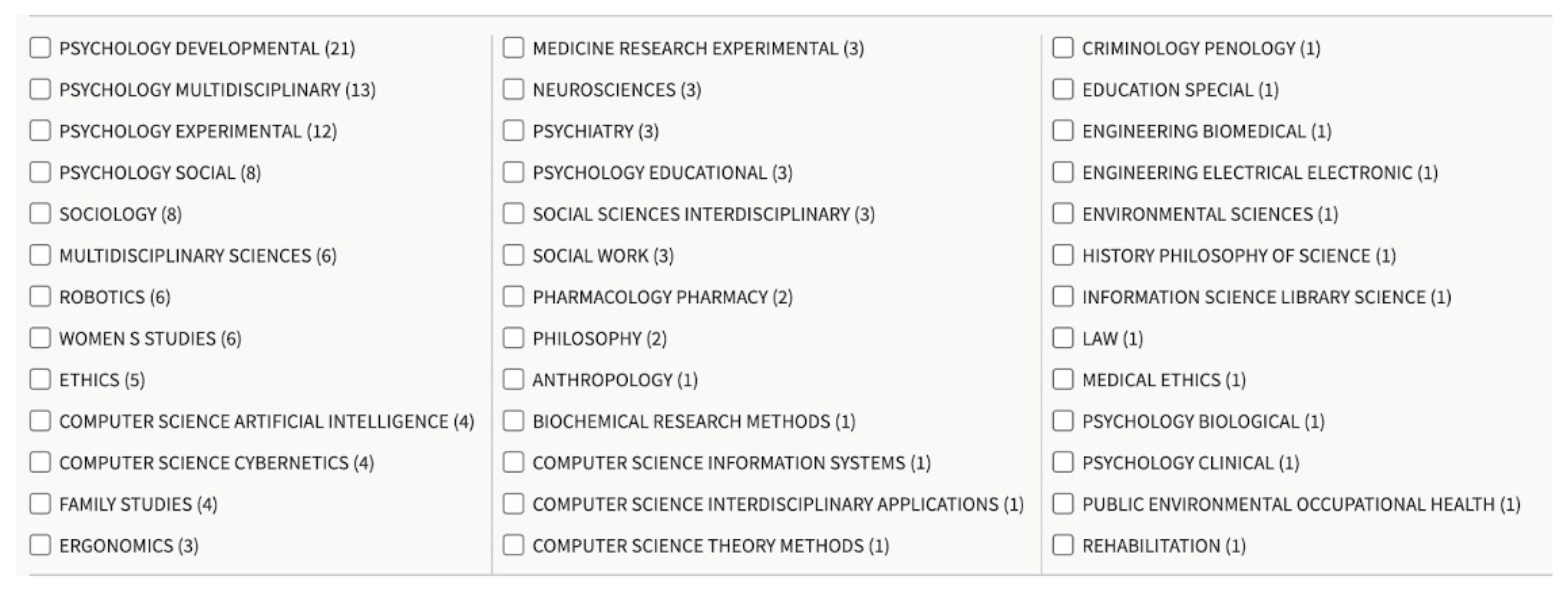
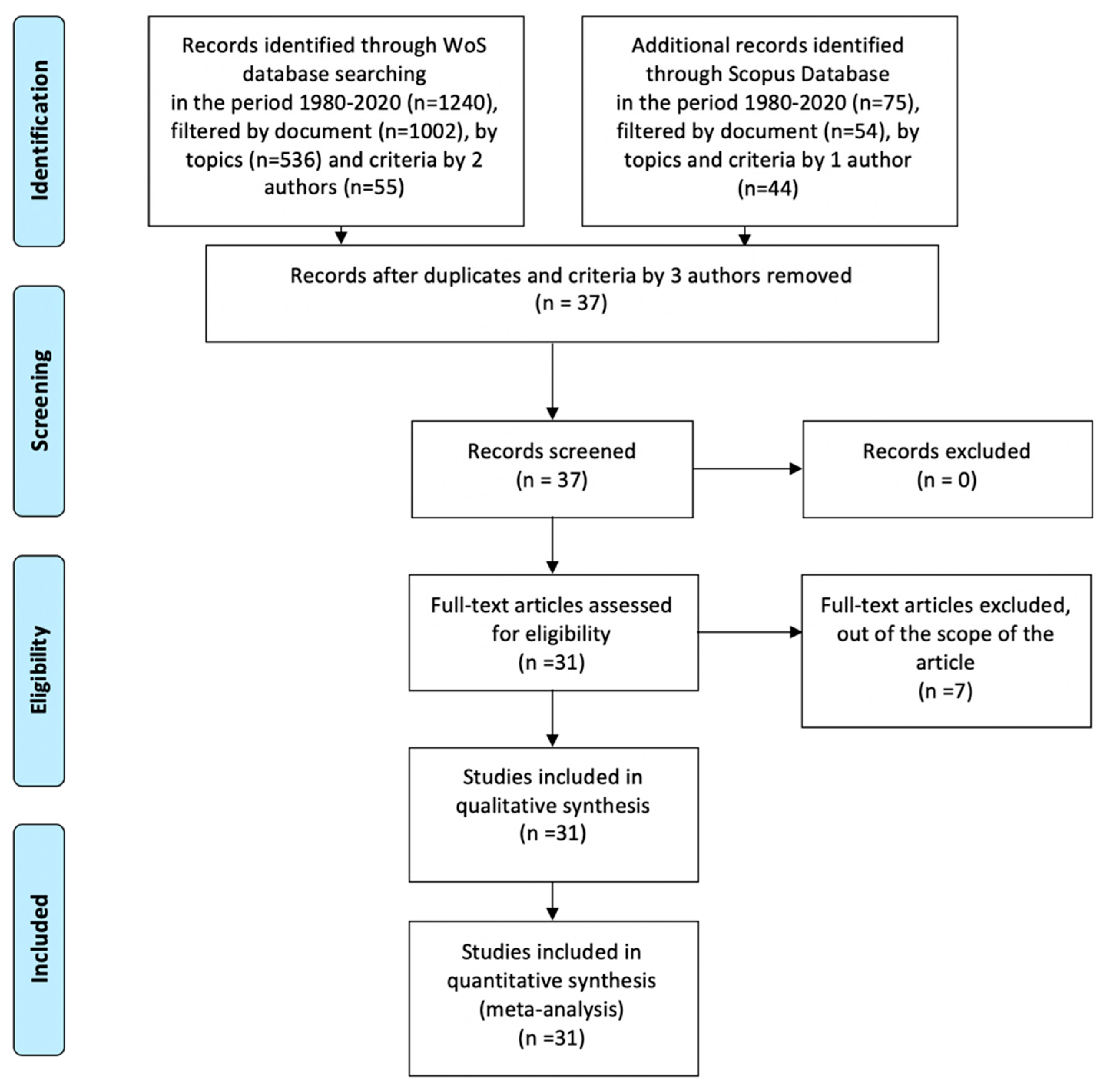
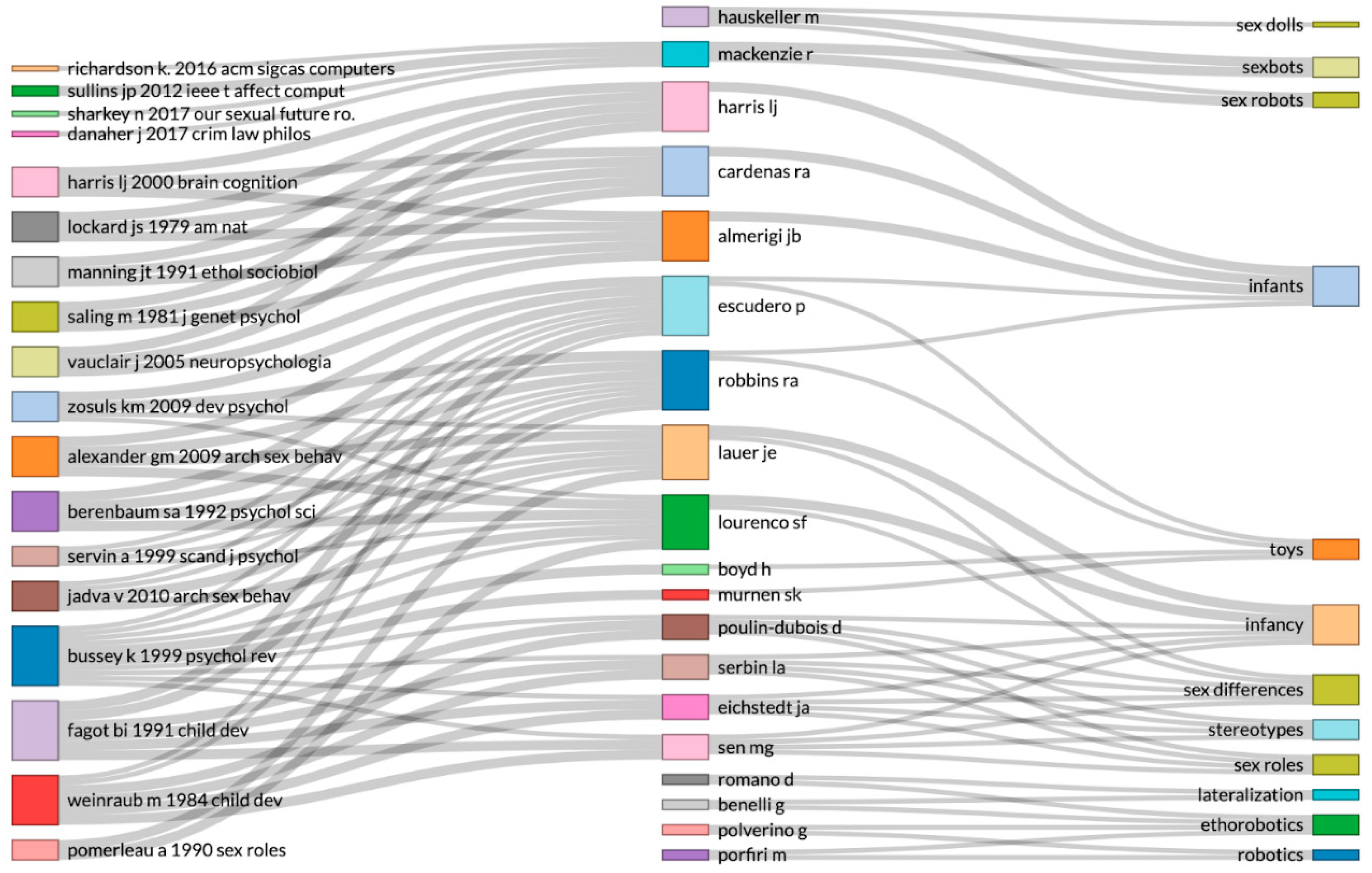
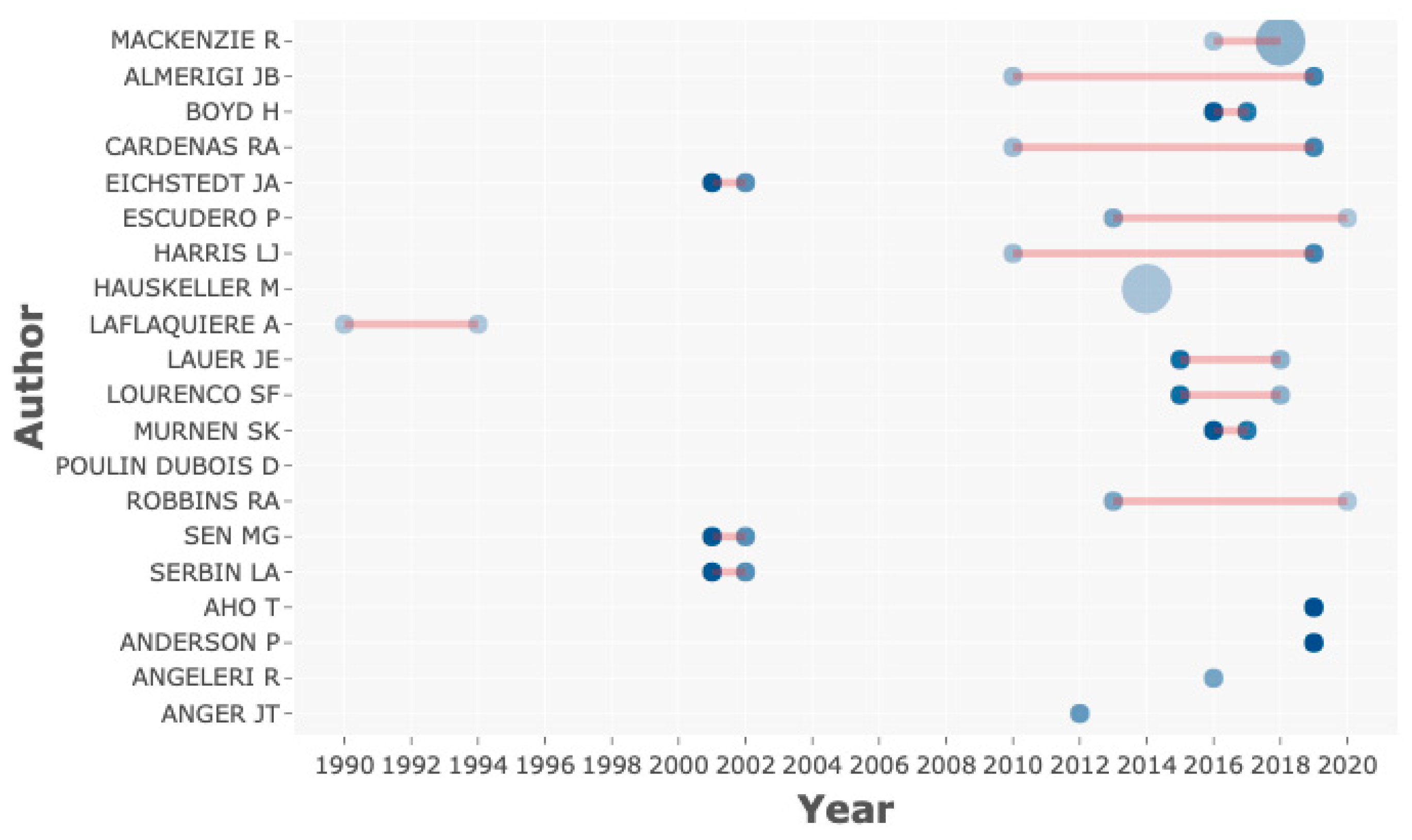
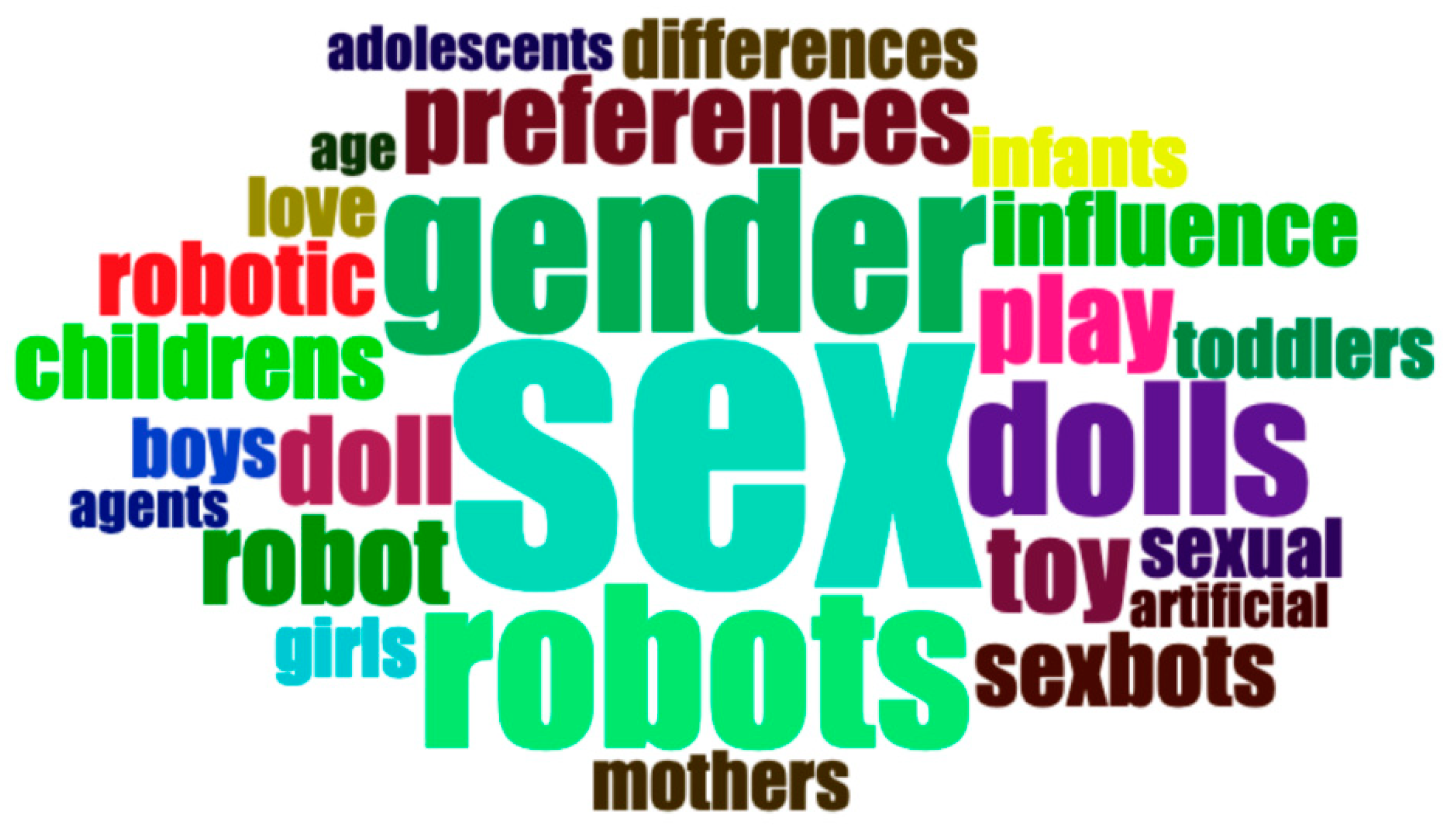
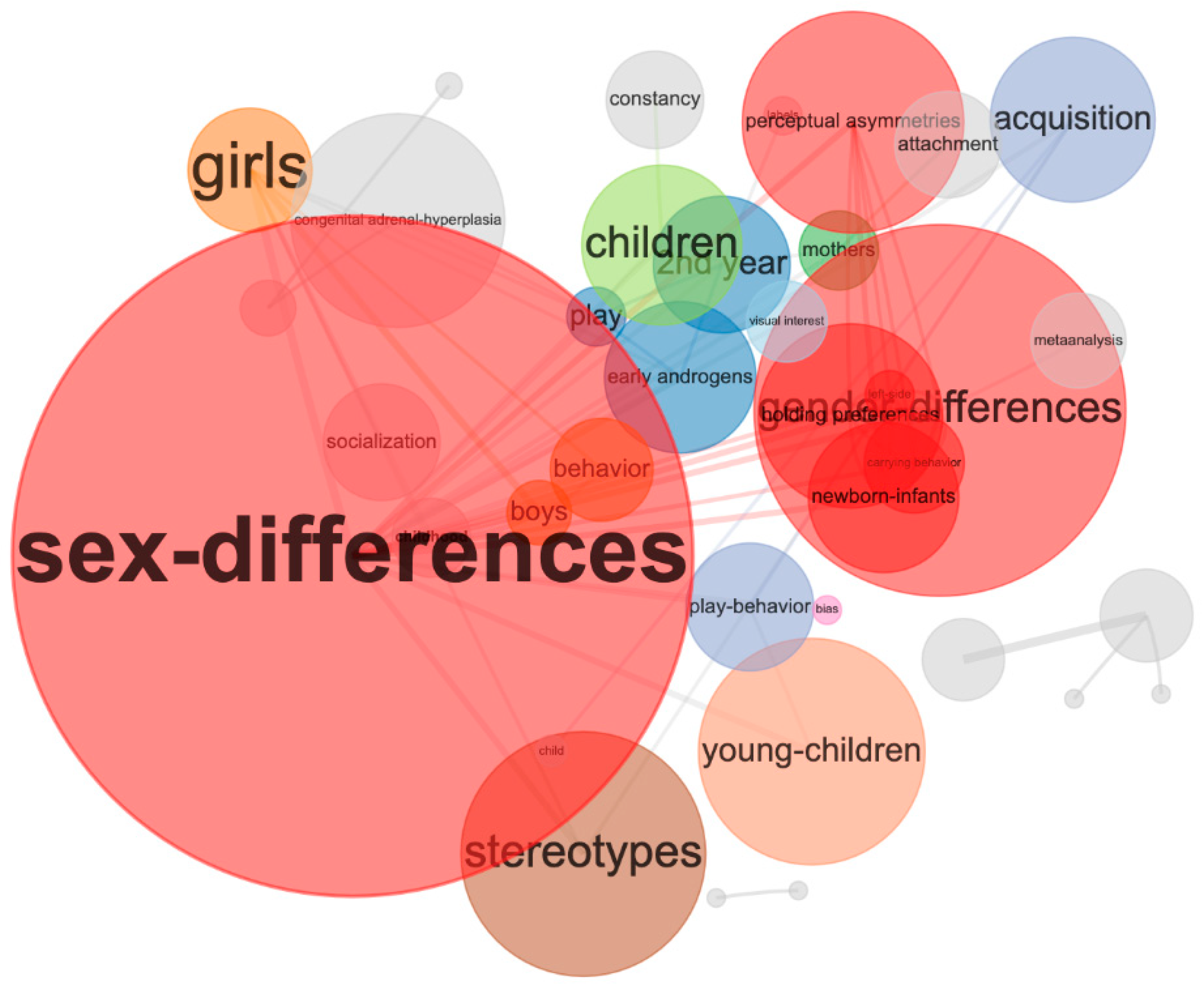
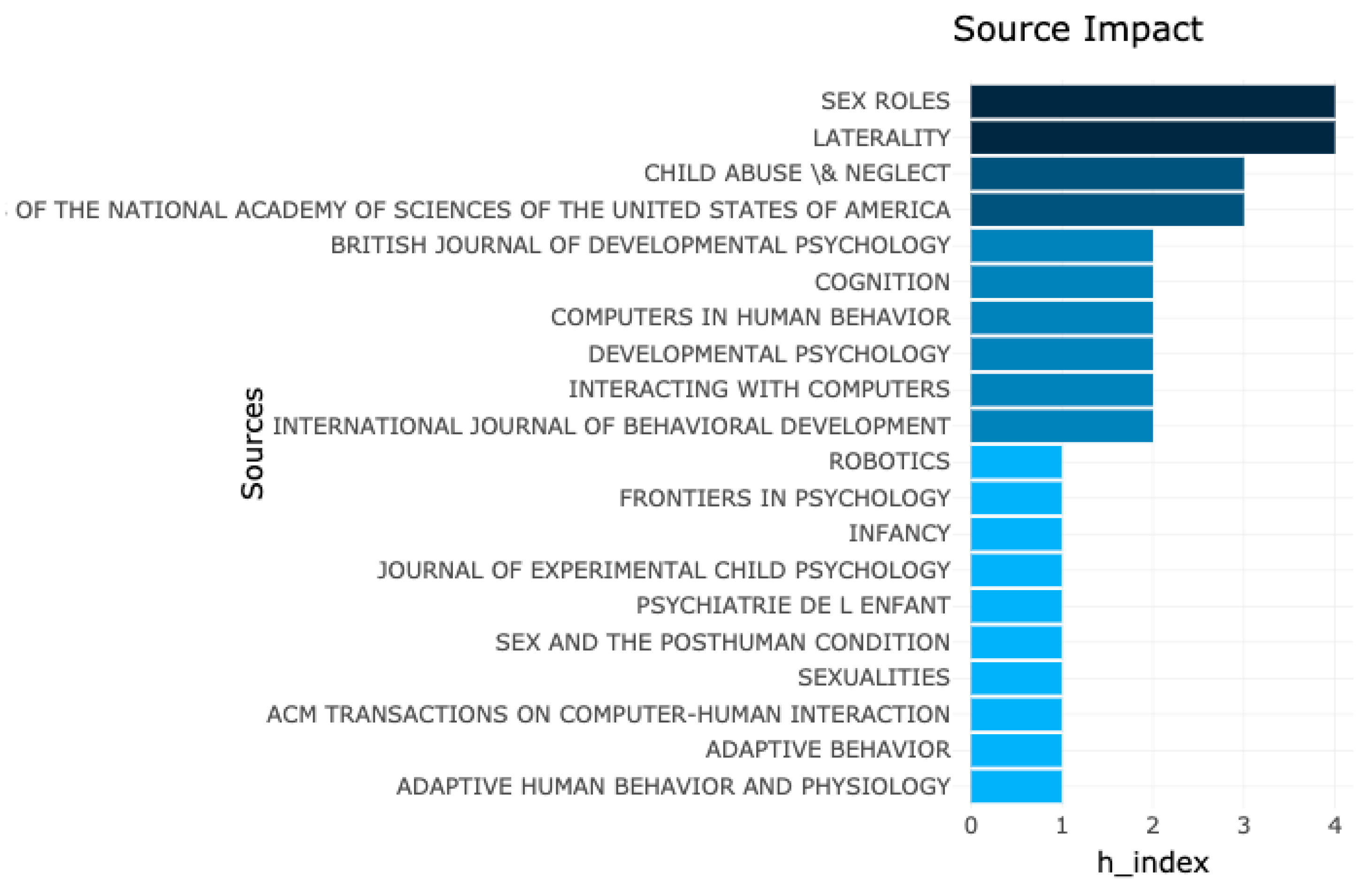
| Authors | Goals | Keywords | Type of Study | Main Outcomes |
|---|---|---|---|---|
| Green, MacDorman, and Vasudevan (2008) [16] | To measure human responses to varying facial proportions in people, androids, mechanical-looking robots, and two/three-dimensional characters | Anthropomorphism, attractiveness perception, facial acceptability, interrater agreement, uncanny valley | Survey study | Significant correlations were made between the selection of best proportions and ratings of human likeness and attractiveness. |
| Norton et al. (1996) [17] | To compare actual proportions of adults’ body shape with dolls (Barbie and Ken) | Social psychology, body shape | Anthropometric study | Unrealistic body proportions of Barbie and Ken were compared to real humans. |
| Szczuka et al. (2017) [18] | To compare men’s sexual attractiveness of sex robots and women | Sex robot, personality traits, attractiveness, HRI | Survey study | A negative attitude towards robots is the main user characteristic that predicts the attractiveness ratings of sex robots. |
| Rousi (2018) [19] | To problematize human–robot love and sex relationships | Emotions, robots, sex, infidelity, artificial intelligence | Review essay | Human–robot love and sex relationships are problematized in the eventuality of artificial emotions. |
| Hou and Ye (2019) [20] | To test out sex differences in preferences for male and female faces and voices | Sex differences facial attractiveness, vocal attractiveness, mate preferences | Computerized test | Men preferred voice recordings and multimodal stimuli of women. Women did not show different attractiveness ratings for the voices of men vs. women. |
| Authors | Goals | Keywords | Type of Study | Main Outcomes |
|---|---|---|---|---|
| Middle week (2020) [21] | To determine the primary function of a sex doll forum for its users and perceptions of sex robot technology | Hegemonic masculinity, homosociality, human–robot relationships, intimacy sex dolls, sex robots | Qualitative analysis study of a major sex doll forum | Peer bonding was the primary factor driving member interaction. Complex and dynamic homosocial relations characterized men’s online interaction. |
| Döring et al. (2018) [22] | To review the state of technological development and research regarding sex toys, sex dolls, and sex robots marketed on the Internet | Sex toys, sex dolls, sex robots, sexual products, positive sexuality, sexual pleasure | Review | Positive impact was found in terms of sex education, sexual therapy, sexual counseling, and sexual well-being for interested target groups (people with disabilities, seniors). |
| James (2017) [23] | To analyze narratives on the sex between anabots and humans | Dystopia | Movie review | The creation of sexual desire as well as the nature of objectification was found. |
| Burr-Miller (2013) [24] | To study how men have a relationship with real dolls | Heteronormativity, gender performativity, sexuality, iDollators, Guys and Dolls | Essay | Men’s violations of the charmed circle are framed in the documentary due to unrequited heterosexual desires. |
| Gomes and Wu (2018) [25] | Design a sex toy for people with disabilities and people in long-distance relationships | Brain-computer interface, sex toys, long-distance relationships | Product design | The Neurodildo, a sex toy remotely controlled by brain waves, which is pressure sensitive and has electrical stimulation (e-stim) feedback, was presented. |
| McArthur and Twist (2017) [26] | To create a design framework for digisexuality | Digisexuality, sexbot, robot, virtual reality, sex therapy | Essay | A framework for understanding the nature of digisexuality and how to approach it is imperative. |
| Tay et al. (2016) [27] | To study humor as an element of interaction between robots and humans | Social robots, humor, social attraction, facial expression | Experimental study | Humor can be an effective way to enrich interactions between humans and robots, but the acceptable types of humor should be carefully selected. |
| Harper and Lievesley (2020) [28] | To examine the veracity of the existing psychological, sexological, and legal literature concerning doll ownership | Sex dolls, sexuality, sex robots, sex offending, sexual abuse prevention | Literature review | There is a lack of analyses of the psychological characteristics or behaviors of sex doll owners. No standardized measure of attitudes towards sex dolls and robots exists. It was found that 70% of owners used the robot as a sexual companion, while 30% used it for social companionship/friendship. |
| Eichenberg, Khamis, and Hübner (2019) [29] | To measure attitudes of sex therapists and physicians toward the therapeutic uses of sex robots | Robotics, sexual health, therapy | Quantitative online survey and a qualitative interview study | Therapists and physicians could recommend sex robots in therapy. Heterogeneous attitudes were found. Psychologists were more critical toward the therapeutic use of sex robots. Patients with social anxiety can benefit from using sex robots. |
| Su et al. (2019) [30] | To examine how people in the future might relate to robots and similar technologies and agents | Sexuality, intimacy, wellness, care, embodiment, robots, online forums | Qualitative analysis of forums | Sex dolls are used for more than just sex. Fiction and intimate fantasies are more persuasive if they are customizable (sexual robots). |
| Langcaster-James and Bentley (2018) [31] | To explore motivations and experiences of those who purchase and use sex dolls | Sex doll, sex robots, companionship, posthuman kinship, allodoll | Mixed methods | Some doll owners appeared to establish a rich fantasy life, generating characters and personalities for their dolls and considering what they might think or say. |
| Döring and Poeschl (2019) [32] | To analyze media representations of intimate human–robot relationships | Human–robot relationships, sex robots, media representation, sexual script theory, gender roles, media content analysis | Content analysis | Media often portray the involved robot partner as a humanoid female sex robot. Nonfictional media describe intimate human–robot relationships more often in sexual terms; fictional media focus more on emotional aspects. |
| Authors | Goals | Keywords | Type of Study | Main Outcomes |
|---|---|---|---|---|
| Whitby (2008) [33] | To make ethical recommendations for designers | Robot ethics, abusive interaction, ethical design | Essay | Reflections on the sexual-affective effects of uses of sex robots were found. Robots that behave similarly as humans do are precisely the sort of robots most likely to be abused. |
| Chatterjee (2020) [34] | To explore the debate on whether child sex dolls and robots could and should be caught by the child protection framework | Child sex dolls, child sex robots, criminalization | Essay | New crimes under the Sexual Offences Act 2003 (SOA) were proposed. |
| Brown et al. (2019) [35] | To analyze the risk and possible negative impacts of the use of child sex dolls | Child sex dolls, crime, criminal justice | Review | Interaction with child sex dolls could increase the likelihood of child sexual abuse and normalize the behavior in the abuser’s mind. |
| Ángel (2016) [36] | To explore the risks of the hybridization process and simulations | Feminism, gender violence, media, biotechnology, simulations | Analysis | It is essential to incorporate the gender perspective into the technological impact. |
| Yulianto (2019) [37] | To study the ethical issues and legal regulations of sex robots | Transhumanism, human enhancement, posthuman | Essay | Human-nature ethics, such as deontological or consequentialist ethics, are not suitable for machine morality. |
| Connor (2015) [38] | To explore the objectification of women through sex dolls | Dolls, women, objectification | Essay | The doll brings together the histories of sexual desire and religion. |
| Mackenzie (2018) [5] | To debate on sex robots and their social interaction with humans | Sexbot, roboethics, robot law, and right | Review essay | The ethical limits and legal implications of customizable human-like robots must be addressed urgently. |
| Frank and Nyholm (2017) [39] | To explores the designing of humanoid robots | Sex robots, rape, artificial intelligence, consent, legal community | Review, discussion | The discussion on whether it is conceivable, possible, and desirable that humanoid robots should be designed such that they can consent to sex was explored. |
| Ess (2017) [40] | To explore love and sex between robots and humans | Social robot, sexuality, love, and sex | Philosophical dissertation, essay | Social robots lack substantial autonomy, genuine emotion, and self-awareness, thereby falling short of what is required by the complete experience of sex to establish experiences of mutual desire, love, and respect. |
| Brahnam and De Angeli (2012) [41] | To explore gender affordances of conversational agents | Sexuality and HCI, gender, agent abuse, embodied conversational agents, sex stereotypes | Test | The application of gender stereotypes in the interaction with chatterbots often leads to attitudes more dismissive toward women than men. |
| Danaher (2019) [42] | To debate on regulatory issues about child sexual robots | Legal regulation, child sexual robots, experimentation, restrictions | Essay | The restrictive approach to regulation is the wisest choice. |
| Headleand, Teahan, and Cenydd (2020) [43] | To explore ethical safeguards into sexual robots as well as artificial morality in robots/agents | Sexbots, artificial sexuality, artificial ethical agent, moral agency | Literature review | Commercializing sex with robots could reinforce existing gender inequalities and sexual objectification. No consensus on what is considered moral between cultures exists. Review also covers ethical boundaries and contributes to moral philosophy. |
| Fiske, Henningsen, and Buyx (2019) [44] | To explore ethical and social implications of translating embodied AI applications into mental health care | Artificial intelligence, robotics, ethics, psychiatry, psychology, psychotherapy, medicine | Literature review | New modes of treatment and opportunities were presented. A lack of guidance on the development of AI applications was found. Gaps in ethical and regulatory frameworks exists. Harm prevention and data ethics issues were covered. |
| Nordmo et al. (2020) [45] | To explore relationships and gender differences about platonic love robot or a sex robot | Robot, relationships, jealousy, gender differences, companionship, sex, artificial intelligence | Online study (vignette about a sexual robot) | Females have less positive views of robots, and especially of sex robots, compared to men. People project their feelings about robots onto their partner. |
Publisher’s Note: MDPI stays neutral with regard to jurisdictional claims in published maps and institutional affiliations. |
© 2020 by the authors. Licensee MDPI, Basel, Switzerland. This article is an open access article distributed under the terms and conditions of the Creative Commons Attribution (CC BY) license (http://creativecommons.org/licenses/by/4.0/).
Share and Cite
González-González, C.S.; Gil-Iranzo, R.M.; Paderewski-Rodríguez, P. Human–Robot Interaction and Sexbots: A Systematic Literature Review. Sensors 2021, 21, 216. https://doi.org/10.3390/s21010216
González-González CS, Gil-Iranzo RM, Paderewski-Rodríguez P. Human–Robot Interaction and Sexbots: A Systematic Literature Review. Sensors. 2021; 21(1):216. https://doi.org/10.3390/s21010216
Chicago/Turabian StyleGonzález-González, Carina Soledad, Rosa María Gil-Iranzo, and Patricia Paderewski-Rodríguez. 2021. "Human–Robot Interaction and Sexbots: A Systematic Literature Review" Sensors 21, no. 1: 216. https://doi.org/10.3390/s21010216
APA StyleGonzález-González, C. S., Gil-Iranzo, R. M., & Paderewski-Rodríguez, P. (2021). Human–Robot Interaction and Sexbots: A Systematic Literature Review. Sensors, 21(1), 216. https://doi.org/10.3390/s21010216







